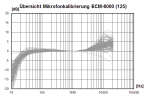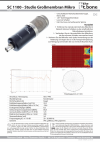Given I already have a Motu M2 interface, I'm thinking about getting a Dayton Audio EMM-6 instead of the so famous UMIK-1 and save €20.
From what I've read both are supposed to have calibration files provided by the manufacturer and should be somewhat equivalent quality/accuracy wise, although I recently found a couple of comments here saying that the calibration files for EMM-6 aren't very good...
How true is this? Are EMM-6 calibration files really that bad (compared to the UMIK-1)?
Or perhaps those persons complaining about it have very crappy interfaces or forgot to first run the calibration for the audio interface before connecting the mic?
I will be using it with REW, for room treatment/speaker placement and also to do some comparisons between different speakers.
Shall I go for the EMM-6? Or shall I ditch the extra €20 for the UMIK-1?
I already have a large diaphragm mic that I've used for some preliminary tests with REW, but I understand this doesn't have a very flat freq. response, so I'm considering buying an actual measurement mic with calibration file. If EMM-6 (or UMIK-1 for that matter) can't provide a reliable calibration, then it's not even worth buying I guess.
TIA
From what I've read both are supposed to have calibration files provided by the manufacturer and should be somewhat equivalent quality/accuracy wise, although I recently found a couple of comments here saying that the calibration files for EMM-6 aren't very good...
How true is this? Are EMM-6 calibration files really that bad (compared to the UMIK-1)?
Or perhaps those persons complaining about it have very crappy interfaces or forgot to first run the calibration for the audio interface before connecting the mic?
I will be using it with REW, for room treatment/speaker placement and also to do some comparisons between different speakers.
Shall I go for the EMM-6? Or shall I ditch the extra €20 for the UMIK-1?
I already have a large diaphragm mic that I've used for some preliminary tests with REW, but I understand this doesn't have a very flat freq. response, so I'm considering buying an actual measurement mic with calibration file. If EMM-6 (or UMIK-1 for that matter) can't provide a reliable calibration, then it's not even worth buying I guess.
TIA






